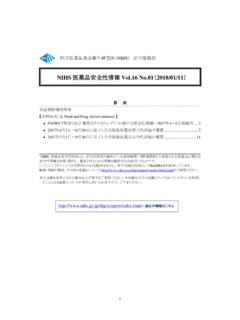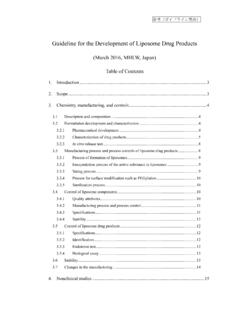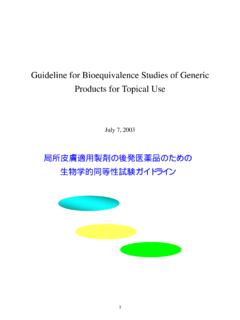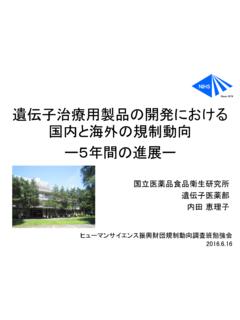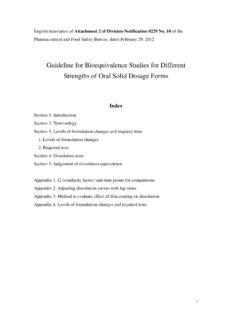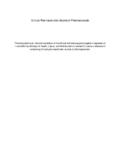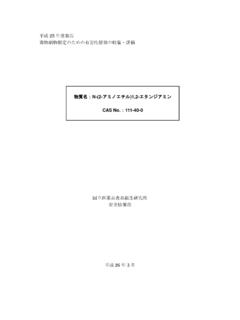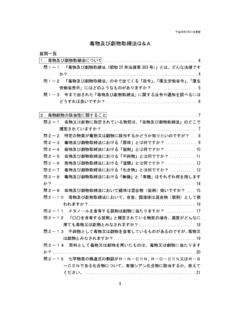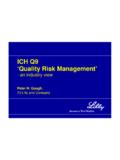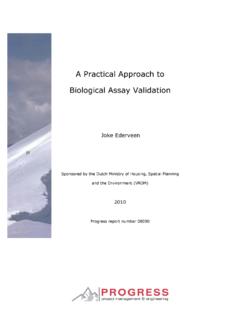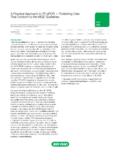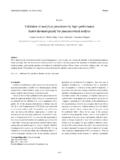Transcription of Sakura Bloom Tablets P2 Mock - NIHS
1 mock P2 English version Sakura Bloom Tablets 1 Sakura Bloom Tablets P2 mock Disclaimer This mock provides an example of the contents to be included in CTD Pharmaceutical Development section for a drug product that had been developed by using the Quality by Design (QbD) methodology presented in ICH Q8, Q9, Q10 and Q11. It is supposed to be into CTD Module (Quality Overall Summary). In addition, in order to help readers better understanding, some additional contents corresponding to Manufacture and Control of Drug Product are also included in this mock . The purpose of this mock is to envision development of drug product (more specifically, film-coated Tablets containing new chemical entity) using the Enhanced Approach methodology (whose definition is the same as advanced methodology or QbD approach). Note that we are not intending to create any new regulatory requirement or eliminate any existing regulatory requirement.
2 Also, note that this mock may not cover all the items to be required for or CTD Module 2. While there was an expectation that a QOS normally should not exceed 40 pages of text excluding Tablets and figures as the CTD guideline (June 21st, 2009, Iyakuhin #899, appendix 3) was implemented, we didn t adhere to this point in authoring this mock because we believe that we should show the reviewers not only data but additional background for understanding of the product and process. Thus, this mock was prepared without taking account of page restriction. Note that this P2 mock is intended for JNDA (New Drug Application in Japan) but not for US NDA or EU MAA. It is also noted that while a QOS is considered a primary review document to reviewers in Japan, its role may be different in review of the US NDA or the EU MAA. In Japan, the CMC contents provided in the Application Form (Module 1) will only be considered regulatory commitments.
3 Sakura Bloom Tablets mock Sub-group MHLW sponsored QbD Drug Product Study Group February 2015 mock P2 English version Sakura Bloom Tablets 2 Permeable International conference on harmonization of technical requirements for registration of pharmaceuticals for human use (ICH) has developed the policy that enhanced QbD (Quality by Design) approach based on pharmaceutical science and quality risk management concept in pharmaceutical development and quality control enables pharmaceutical industries to obtain regulatory flexibility [ICH Q8(R2)]. Indicating the example of enhanced QbD approach in pharmaceutical development has been considered to promote the effective evaluation of the product development study on the basis of common understanding between regulatory authorities and industries. One of the advantages to employ enhanced QbD approach defined in ICH Q8(R2) is application of Real Time Release Testing (RTRT) with comprehensive process understanding and Process Analytical Technology (PAT).
4 Although the RTRT has a potential advantage for pharmaceutical industry, there are very limited practical examples to apply RTRT with enhanced QbD approach, especially in Japanese domestic companies. The potential reason is considered complicated relationship between design space and RTRT defined in ICH Q8(R2), and practical difficulty in establishing the design space described in the mock -up or case study at the public domain. "Material attribute" and "process parameter" become the keywords in considering relations of design space and RTRT. In " Sakura Tablets " of quality overall summary P2 mock -up (description example) concerning the public welfare labor science research, not only material attributes like the particle size of drug substance, but also "process parameter" like the lubricant blending time or compression pressure are included in the factor that composes the design space of Sakura Tablets .
5 These material attribute and process parameters in addition to the lubricant specific surface area are included as the factor of dissolution RTRT prediction model, and this equation is described in justification of specification and test methods in the mock -up application form. However, for example, the possibility that so-called major change as a regulatory action occurs is very high when commercial manufacturing blender is changed leading to changes in the blending time to obtain suitable blending state as before, if the design space is constructed using process parameters. This shows that the enhanced QbD approach to which regulatory flexibility is sure to improve may have a critical issue with less regulatory flexibility if the process parameter is employed for the factor that composes the design space and RTRT like Sakura Tablets . So we decided to create a mock -up CTD P2 Sakura Bloom Tablets in which critical material attributes (CMAs) are used as the factors for not only RTRT model calculation but also design space construction in order to solve the issue where the process parameters were excluded from the design space factor as much as possible, and the factors for RTRT are connected directly to those of design space.
6 This approach is intentional since the resultant design space factors to be also used for RTRT are not linked to equipment or process parameters and therefore are site, scale, and equipment independent. In this mock -up, CMAs are controlled with PAT tools within the appropriate range adjusting process parameters. Also, the fluidized bed granulation method that is one of the typical manufacturing methods in the Japanese domestic companies is adopted, and the concept of Large-N standard examined in our sectional committee and advanced control strategy examples are included for content uniformity of RTRT. mock P2 English version Sakura Bloom Tablets 3 Contents Description and Composition of the Drug Product ( Sakura Bloom Tablets , Film-coated Tablet) Pharmaceutical Development ( Sakura Bloom Tablets , Film-coated Tablet) Components of the Drug Product Drug Substance Excipients Drug Product Formulation Development Overage Physicochemical and Biological Properties Development of manufacturing processes Initial risk assessment Determination of CMAs affecting each CQA Indentification of p-CMAs Identification of CMA Determination of CPPS affecting each CMA Extraction of potential CPPs (p-CPPs) Identification of CPP Construction of the control strategy Uniformity of dosage units (CQA) Assay (CQA) Dissolution (CQA)
7 Specifications except for CQA Review of the risk assessment after implementation of the control strategy Risk assessment of CMA Risk assessment of CPP Overall evaluation of risk assessment Container Closure System Microbiological Attributes Compatibility mock P2 English version Sakura Bloom Tablets 4 Manufacture Manufacturing Process and Process Control Manufacturing Parameters and Criteria Control Method Monitoring of Quality Attribute Granulation process Tableting Process Inspection process Control of Critical Process and Critical Intermediates Test items for RTRT Description (appearance) (RTRT) Identification RTRT Uniformity of dosage units Dissolution Assay Process Validation/Evaluation Control of Drug product Specifications and Test Methods Test Methods (Analytical Procedures) Description Test Methods of RTRT Test methods of conventional tests Identification Test Methods of RTRT Test methods of conventional tests Uniformity of dosage units Test Methods of RTRT Test methods of conventional tests Dissolution Test Methods of RTRT mock P2 English version Sakura Bloom Tablets 5 Test methods of conventional tests Assay Test Methods of RTRT Test methods of conventional tests Validation of Test Methods (Analytical Procedures) Validation of Test Methods for RTRT (Analytical Procedures)
8 Drug substance concentrations of uncoated Tablets <on-line NIR method> Identification <at-line NIR method> Validation of test methods necessary for stability studies (analytical procedures) Justification of Specification and Test Methods Uniformity of dosage units Uniformity of dosage units RTRT Dissolution Dissolution (conventional test) Dissolution RTRT Assay Attachment Justification of Specifications when the Real Time Release Testing is Employed for Uniformity of Dosage Units mock P2 English version Sakura Bloom Tablets 6 MODULE 2: COMMON TECHNICAL DOCUMENT SUMMARIES Generic name: Prunus QUALITY OVERALL SUMMARY Sakura Bloom Tablets mock P2 English version Sakura Bloom Tablets 7 Description and Composition of the Drug Product ( Sakura Bloom Tablets , Film-coated Tablet) The composition of Sakura Bloom Tablets is shown in Table Table Composition of Sakura Bloom Tablets Function Specification Ingredient Amount Drug substance In-house specification Prunus 20 mg Diluent JP e) Lactose Hydrate Diluent JP e) Microcrystalline Cellulose a) 20 mg Binder JP e) Hydroxypropylcellulose 6 mg Disintegrant JP e) Croscarmellose Sodium 10 mg Sub-total granule 192 mg Lubricant JP e) Magnesium Stearate 2 mg Sub-total uncoated tablet 194 mg Coating agent JP e) Hypromellose b) mg Polishing agent JP e) Macrogol 6000 mg Coloring agent JP e) Titanium Oxide mg Coloring agent JPE f)
9 Red Ferric Oxide Trace amount Sub-total coating layer 6 mg Total 200 mg Container Closure System PTP/Al c) 500 Tablets /bottled d) a) Mean degree of polymerization, 100 to 350; loss on drying, or less; bulk density, to g/cm3 b) Substitution type, 2910; viscosity, 6 mPa s c) Polypropylene on one side and aluminum foil on the other side d) Polyethylene bottle + plastic cap e) Japanese Pharmacopoeia f) Japanese Pharmaceutical Excipients mock P2 English version Sakura Bloom Tablets 8 Pharmaceutical Development ( Sakura Bloom Tablets , Film-coated Tablet) Components of the Drug Product Drug substance The physicochemical properties of prunus, the drug substance of Sakura Bloom Tablets , are shown in Section General Properties. Prunus is a basic compound with a molecular weight of 450, having poor wettability and a metal adherability. The solubility decreases with increasing pH, with a low solubility in an alkaline solution at 37 C.
10 Sakura Bloom Tablets contain 20 mg of prunus, which is classified as a low solubility compound according to the Biopharmaceutical Classification System (BCS). The 1-octanol/water partition coefficient (log D) of prunus is at 25 C, and based on the measured permeability across Caco-2 cell membranes, prunus is classified as a high permeability compound according to BCS. From these results, prunus is classified as a BCS class 2 compounds (low solubility and high permeability). Figure Solubility of prunus in buffers at various pH Solubility ( g/ml) mock P2 English version Sakura Bloom Tablets 9 Excipients Excipients used in Sakura Bloom Tablets have good compatibility with drug substance and the compatibility test results showed neither a change in appearance, an increase in related substances nor a decrease in assay. To select a diluent, uncoated Tablets were prepared with lactose hydrate, D- mannitol, or microcrystalline cellulose, and evaluated for dissolution and hardness.
